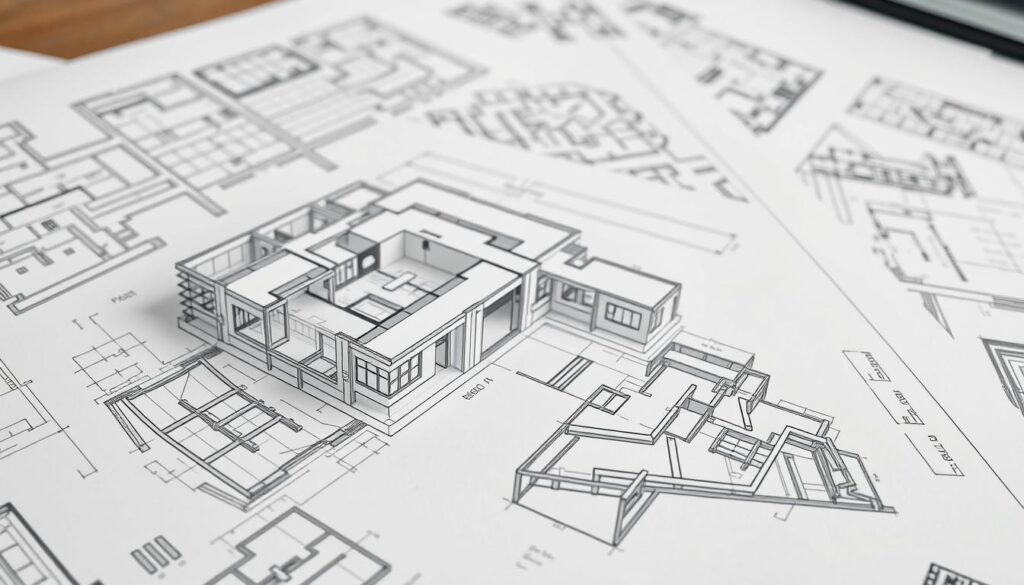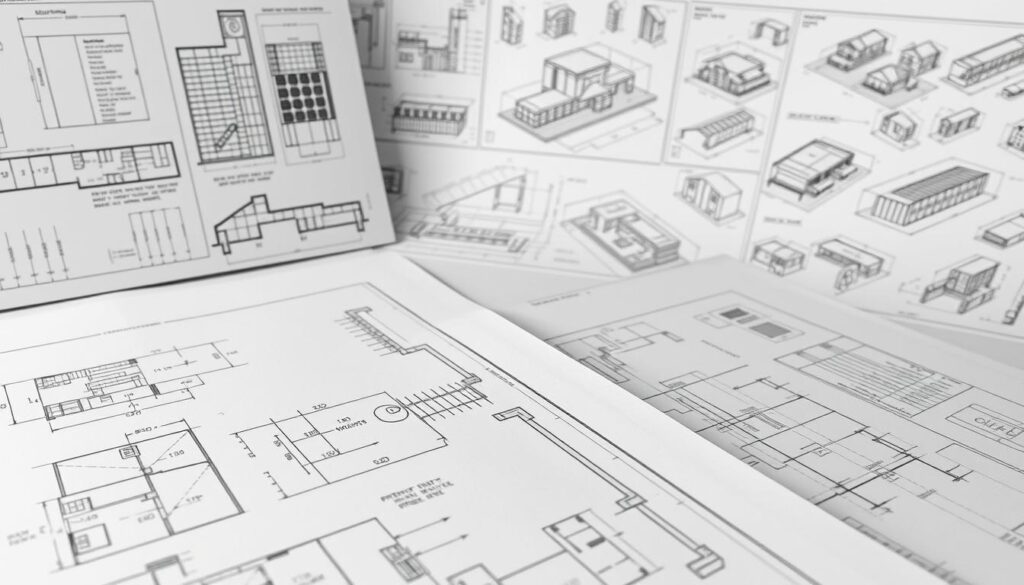For those new to civil engineering, understanding drawings is a crucial skill. These drawings serve as a blueprint for construction projects, conveying vital information about the design and implementation.
Civil engineering drawings are more than just diagrams; they are a language that communicates the specifics of a project, from dimensions and materials to the sequence of construction.
Mastering the ability to read these drawings is essential for anyone looking to succeed in the field of civil engineering. This article will provide a comprehensive guide to understanding these complex documents.
Key Takeaways
- Understanding civil engineering drawings is vital for construction projects.
- These drawings convey critical information about design and implementation.
- Mastering the skill of reading drawings is essential for civil engineering professionals.
- Civil engineering drawings include details on dimensions, materials, and construction sequences.
- This guide will walk beginners through the process of interpreting these complex documents.
Understanding the Basics of Civil Engineering Drawings
The ability to read and interpret civil engineering drawings is a critical skill for engineers, architects, and contractors alike. These drawings are not just simple diagrams; they are detailed documents that convey complex information about a project’s design, dimensions, and materials.
The Purpose and Importance of Engineering Drawings
Engineering drawings serve as a universal language in the construction industry, facilitating communication among stakeholders. They provide a visual representation of a project, including its layout, dimensions, and specifications. The accuracy and clarity of these drawings are crucial for the successful execution of a project.
“A picture is worth a thousand words,” especially in civil engineering, where a single drawing can convey complex information more effectively than pages of written descriptions.
Standard Drawing Formats and Layouts
Civil engineering drawings follow standard formats to ensure consistency and readability. These standards include specific guidelines for title blocks, sheet organization, and drawing hierarchy.
Title Blocks and Drawing Information
The title block is a critical component of an engineering drawing, containing essential information such as the project name, drawing title, scale, and revision history. This information is vital for understanding the context and specifics of the drawing.
Sheet Organization and Numbering Systems
Engineering drawings are often organized into multiple sheets, each with its own specific purpose and numbering system. This organization helps in navigating the drawings and ensures that all components of the project are properly referenced.
Drawing Hierarchy and Organization
The hierarchy of drawings refers to the level of detail and the sequence in which the drawings should be read. Typically, drawings progress from general overviews to detailed specifications. Understanding this hierarchy is key to interpreting the drawings correctly.
| Drawing Type | Purpose | Level of Detail |
|---|---|---|
| Site Plans | Show the overall layout of the project | Low to Medium |
| Structural Drawings | Detail the structural elements of the project | Medium to High |
| Detail Drawings | Provide detailed specifications of specific components | High |
Essential Tools for Reading Engineering Drawings
Reading construction drawings requires a combination of physical tools, digital software, and reference materials. To effectively interpret these drawings, beginners must familiarize themselves with the necessary tools and resources.
Physical Tools: Scales, Templates, and Measuring Devices
Physical tools are essential for measuring and analyzing drawings. These include:
- Scales: for measuring distances and sizes
- Templates: for drawing symbols and shapes accurately
- Measuring devices: such as calipers and micrometers for precise measurements
Digital Tools and Software for Drawing Interpretation
Digital tools have revolutionized the field of engineering drawing. Software such as AutoCAD and Revit enables users to create, edit, and analyze drawings digitally.
Reference Materials Every Beginner Should Have
Reference materials provide crucial information for interpreting drawings. These include:
Standard Codes and Specifications
Understanding standard codes and specifications is vital for ensuring compliance with industry regulations.
Industry Handbooks and Guides
Industry handbooks and guides offer detailed information on best practices and standards in civil engineering.
By combining physical tools, digital software, and reference materials, beginners can develop a comprehensive understanding of engineering drawings.
How to Read Drawing in Civil Engineering for Beginners?
Reading civil engineering drawings can seem daunting at first, but with a step-by-step approach, it becomes manageable. To start, it’s essential to understand the components and layout of these drawings.
Step-by-Step Approach to Drawing Interpretation
Interpreting civil engineering drawings requires a systematic approach. The first step involves understanding the general notes and key elements presented in the drawing.
Starting with the General Notes
General notes provide crucial information about the project, including materials, construction methods, and other relevant details. Always start by reading these notes carefully as they set the context for the entire drawing.
Identifying Key Elements and Features
Once you’ve gone through the general notes, identify the key elements and features of the drawing. This includes understanding the different symbols, annotations, and dimensions used.
Developing a Systematic Reading Method
To read civil engineering drawings efficiently, develop a systematic method. This involves cross-referencing different parts of the drawing, understanding the scale and dimensions, and recognizing the various symbols and annotations used.
| Step | Description |
|---|---|
| 1 | Read general notes and understand the project context |
| 2 | Identify key elements and features in the drawing |
| 3 | Cross-reference different parts of the drawing |
Practice Exercises for Beginners
Practice is key to mastering the skill of reading civil engineering drawings. Beginners can start by practicing with simple drawings and gradually move on to more complex projects.
By following these steps and practicing regularly, beginners can develop their skills in reading civil engineering drawings and become proficient in interpreting these complex documents.
Decoding Common Symbols and Annotations
To accurately read civil engineering drawings, one must first master the art of decoding symbols and annotations. These elements are the language of engineering drawings, conveying critical information about the design, materials, and construction methods.
Standard Symbols in Civil Engineering
Civil engineering drawings utilize a variety of standard symbols to represent different elements. Understanding these symbols is crucial for interpreting drawings correctly.
Structural Symbols and Notations
Structural symbols represent various structural elements such as beams, columns, and foundations. For instance, a beam is often represented by a rectangle with specific notations indicating its size and material.
Site and Utility Symbols
Site and utility symbols denote features like roads, utilities, and boundaries. These symbols help in understanding the site layout and the location of various utilities.
| Symbol | Description |
|---|
| Represents a specific type of utility line | |
| Rectangle with diagonal lines | Indicates a structural column |
Annotation Conventions and Abbreviations
Annotations and abbreviations provide additional information about the elements represented in the drawings. Familiarity with common annotation conventions is essential for accurate interpretation.
Material Indications and Specifications
Understanding how materials are indicated in drawings is vital. Different materials are represented by various symbols, patterns, or notations, and specifications are often provided in the form of annotations or in separate schedules.
By mastering the decoding of symbols and annotations, civil engineers can ensure that projects are executed according to the intended design and specifications.
Understanding Scales and Dimensions
To decipher civil engineering drawings, one must grasp the concepts of scales and dimensions. Scales allow for the representation of large structures on manageable media, while dimensions provide the necessary measurements for construction.
Working with Different Scale Types
Civil engineering drawings utilize various scale types, including graphical scales and representative fractions. Understanding the differences between these scales is crucial for accurate drawing interpretation.
For instance, a graphical scale is a visual representation that allows users to measure distances on the drawing directly. On the other hand, a representative fraction (e.g., 1:100) indicates the ratio of the drawing size to the actual size of the structure.
Converting Between Imperial and Metric Measurements
In a globalized construction industry, the ability to convert between imperial and metric measurements is invaluable. This skill ensures that projects can be executed accurately regardless of the measurement system used in the drawings.
For example, converting a dimension from feet to meters requires a straightforward calculation, but it’s critical for maintaining precision.
Dimensioning Practices and Standards
Dimensioning practices vary between different standards and jurisdictions. However, certain principles remain constant, such as the use of clear and consistent notation.
Linear Dimensions
Linear dimensions are used to specify the length, width, and height of structural elements. These dimensions are typically represented in a clear and straightforward manner.
Angular Dimensions and Elevations
Angular dimensions and elevations provide critical information about the orientation and height of structural components. Understanding these dimensions is essential for ensuring that the constructed project matches the design intent.
“The devil is in the details, and in civil engineering, those details are often found in the scales and dimensions of the drawings.” – Anonymous
Interpreting Structural Drawings
Interpreting structural drawings is a vital skill for civil engineers and construction professionals. These drawings provide a detailed representation of a building’s structural elements, including foundations, frames, and reinforcements.

Foundation Plans and Details
Foundation plans are critical in understanding how a structure transfers loads to the ground. They include details about footings, foundation walls, pile foundations, and grade beams.
Footings and Foundation Walls
Footings are the base of a foundation, distributing the weight of the structure across a wider area. Foundation walls, on the other hand, are the vertical elements that transfer loads from the superstructure to the footings.
Pile Foundations and Grade Beams
Pile foundations are used when the soil near the surface cannot support the weight of the building. Grade beams are structural elements that connect pile caps or caissons, providing additional support.
| Component | Description | Representation in Drawings |
|---|---|---|
| Footings | Base of the foundation | Detailed dimensions and reinforcement |
| Foundation Walls | Vertical elements transferring loads | Thickness, height, and material specifications |
| Pile Foundations | Deep foundations for weak soil | Pile diameter, depth, and spacing |
Framing Plans and Structural Elements
Framing plans illustrate the structural framework of a building, including beams, columns, and connections. Understanding these plans is crucial for identifying the load path and structural integrity.
Reinforcement Drawings and Schedules
Reinforcement drawings show the details of how concrete elements are reinforced with steel. Schedules provide a summary of the reinforcement used, including bar sizes, lengths, and quantities.
By mastering the interpretation of structural drawings, civil engineers and construction professionals can ensure that projects are executed correctly and safely.
Mastering Site Plans and Topographical Drawings
Mastering site plans and topographical drawings enables civil engineers to better understand the topography of a site and plan accordingly. These drawings are essential for visualizing the site’s layout, boundaries, and existing features, which is critical for the successful execution of construction projects.
Site Layout and Boundaries
Site plans provide a detailed view of the site’s layout, including property boundaries, existing structures, and proposed improvements. Understanding the site layout is vital for ensuring compliance with zoning regulations and for planning the construction process.
Key elements of site layout include:
- Property lines and boundaries
- Existing and proposed structures
- Access roads and pathways
Contour Lines and Elevation Indicators
Topographical drawings use contour lines to represent the site’s elevation and terrain. These lines are crucial for understanding the site’s topography and for designing drainage systems, grading plans, and other earthwork operations.
Reading Spot Elevations
Spot elevations provide specific elevation points on the site, which are used in conjunction with contour lines to understand the site’s topography in detail. These elevations are critical for designing precise grading plans and ensuring accurate construction.
Understanding Grading Plans
Grading plans are derived from topographical drawings and indicate how the site will be modified to accommodate the proposed construction. Understanding grading plans is essential for ensuring that the site is properly prepared for construction and that drainage and erosion are controlled.
Utility and Infrastructure Elements
Site plans and topographical drawings also include utility and infrastructure elements such as water supply lines, sewage systems, and electrical conduits. Understanding these elements is vital for ensuring that the site is properly serviced and that all necessary infrastructure is in place.
As emphasized by a leading civil engineering expert, “The accuracy of site plans and topographical drawings directly impacts the success of a construction project.” Proper interpretation of these drawings is fundamental to avoiding costly errors and ensuring project timelines are met.
Reading Architectural and MEP Drawings
The ability to read architectural and MEP drawings is a fundamental skill for professionals in the construction industry. These drawings provide critical information necessary for the successful execution of construction projects, including the layout, materials, and systems involved.
Floor Plans and Elevations
Floor plans and elevations are essential components of architectural drawings. Floor plans provide a detailed view of the layout of each floor of a building, including room dimensions, door and window locations, and other architectural features. Elevations, on the other hand, show the exterior of the building from different sides, detailing the design and materials used.
- Floor plans help in understanding the spatial relationships between different areas of the building.
- Elevations are crucial for visualizing the building’s exterior appearance and facade details.
Section Views and Details
Section views are used to illustrate the internal structure of a building or component. They are critical for understanding how different parts of the building are assembled and connected.
Wall Sections and Assembly Details
Wall sections provide detailed information about the construction of walls, including materials used and how different components are assembled. This information is vital for ensuring that the construction is done correctly and safely.
Connection Details and Special Conditions
Connection details show how different structural elements are connected, which is crucial for the stability and integrity of the building. Special conditions, such as unique architectural features or complex connections, are also detailed in these drawings.
“The devil is in the details.” This old adage is particularly true in construction, where the accuracy of drawings directly impacts the safety and quality of the finished project.
Mechanical, Electrical, and Plumbing Elements
MEP drawings are critical for the installation and coordination of mechanical, electrical, and plumbing systems within a building. These drawings ensure that all systems are properly integrated and function as intended.
| MEP System | Description | Importance |
|---|---|---|
| Mechanical | Includes heating, ventilation, and air conditioning (HVAC) systems. | Ensures indoor air quality and comfort. |
| Electrical | Covers power distribution, lighting, and electrical outlets. | Essential for powering building systems and occupant needs. |
| Plumbing | Involves water supply, drainage, and gas distribution systems. | Critical for hygiene, sanitation, and certain industrial processes. |

Coordinating Between Different Drawing Types
The ability to cross-reference and resolve conflicts between different drawing types is vital in civil engineering. Effective coordination ensures that all elements of a project are properly integrated, reducing errors and enhancing overall project quality.
Cross-Referencing Between Plans, Sections, and Details
Cross-referencing is a critical step in engineering drawing interpretation. It involves checking consistency across different views and details to ensure accuracy. For instance, verifying that the dimensions on a plan match those in the detailed sections.
- Use drawing indexes to quickly locate specific sheets and details.
- Cross-reference plans with sections and elevations to ensure consistency.
- Verify that all annotations and symbols are used consistently across drawings.
Resolving Conflicts Between Different Disciplines
Conflicts often arise between architectural, structural, and MEP drawings. Resolving these requires a systematic approach, involving checking the specifications and requirements of each discipline and finding a harmonious solution.
Using Drawing Indexes and Reference Systems
Drawing indexes and reference systems are essential tools for managing complex projects. They help in organizing and navigating through the numerous drawings, ensuring that all team members are on the same page.
By mastering the coordination between different drawing types, civil engineers can significantly improve project outcomes, enhancing both efficiency and accuracy in civil engineering drawings.
Conclusion
Reading civil engineering drawings is a fundamental skill that requires practice, patience, and dedication. This beginner’s guide has covered the essential tools, techniques, and best practices for interpreting these complex documents.
By understanding the basics of civil engineering drawings, including standard formats, symbols, and annotations, beginners can develop a systematic approach to drawing interpretation. Practicing with real-world examples and exercises can help build confidence and proficiency.
As you continue on your journey, remember that mastering civil engineering drawings is a continuous process. Stay motivated, and don’t be afraid to seek guidance from experienced professionals or online resources. With persistence and the right training, you’ll become proficient in reading civil engineering drawings and unlock new opportunities in this field.
